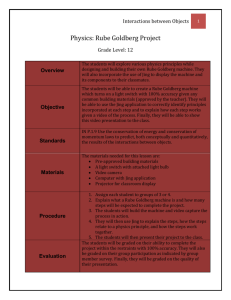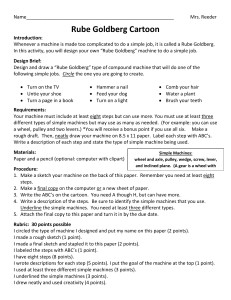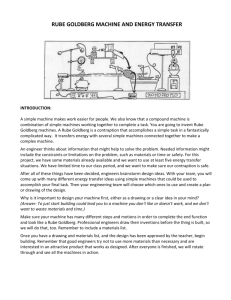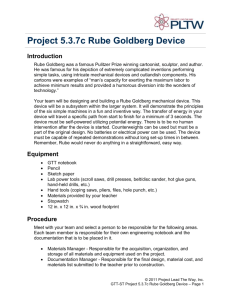Core Technologies: Rube Goldberg Lesson Plan
advertisement
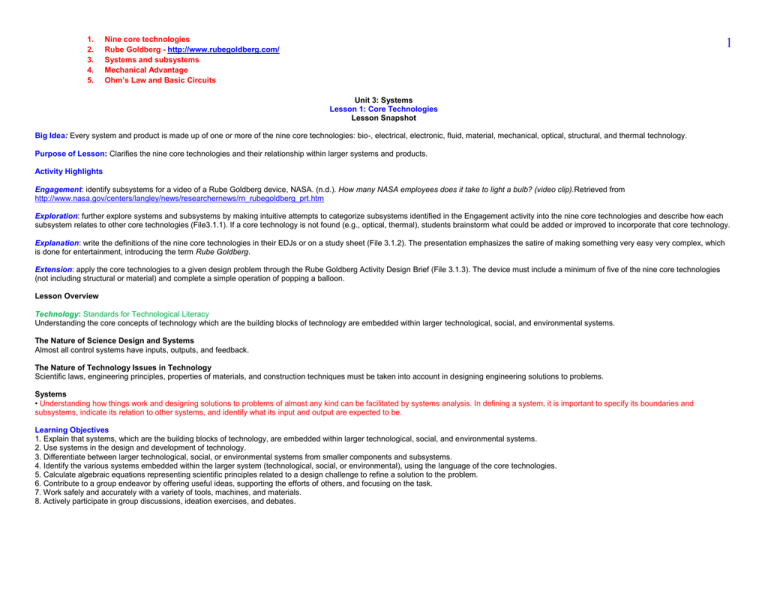
1. 2. 3. 4. 5. Nine core technologies Rube Goldberg - http://www.rubegoldberg.com/ Systems and subsystems Mechanical Advantage Ohm’s Law and Basic Circuits 1 Unit 3: Systems Lesson 1: Core Technologies Lesson Snapshot Big Idea: Every system and product is made up of one or more of the nine core technologies: bio-, electrical, electronic, fluid, material, mechanical, optical, structural, and thermal technology. Purpose of Lesson: Clarifies the nine core technologies and their relationship within larger systems and products. Activity Highlights Engagement: identify subsystems for a video of a Rube Goldberg device, NASA. (n.d.). How many NASA employees does it take to light a bulb? (video clip).Retrieved from http://www.nasa.gov/centers/langley/news/researchernews/rn_rubegoldberg_prt.htm Exploration: further explore systems and subsystems by making intuitive attempts to categorize subsystems identified in the Engagement activity into the nine core technologies and describe how each subsystem relates to other core technologies (File3.1.1). If a core technology is not found (e.g., optical, thermal), students brainstorm what could be added or improved to incorporate that core technology. Explanation: write the definitions of the nine core technologies in their EDJs or on a study sheet (File 3.1.2). The presentation emphasizes the satire of making something very easy very complex, which is done for entertainment, introducing the term Rube Goldberg. Extension: apply the core technologies to a given design problem through the Rube Goldberg Activity Design Brief (File 3.1.3). The device must include a minimum of five of the nine core technologies (not including structural or material) and complete a simple operation of popping a balloon. Lesson Overview Technology: Standards for Technological Literacy Understanding the core concepts of technology which are the building blocks of technology are embedded within larger technological, social, and environmental systems. The Nature of Science Design and Systems Almost all control systems have inputs, outputs, and feedback. The Nature of Technology Issues in Technology Scientific laws, engineering principles, properties of materials, and construction techniques must be taken into account in designing engineering solutions to problems. Systems • Understanding how things work and designing solutions to problems of almost any kind can be facilitated by systems analysis. In defining a system, it is important to specify its boundaries and subsystems, indicate its relation to other systems, and identify what its input and output are expected to be. Learning Objectives 1. Explain that systems, which are the building blocks of technology, are embedded within larger technological, social, and environmental systems. 2. Use systems in the design and development of technology. 3. Differentiate between larger technological, social, or environmental systems from smaller components and subsystems. 4. Identify the various systems embedded within the larger system (technological, social, or environmental), using the language of the core technologies. 5. Calculate algebraic equations representing scientific principles related to a design challenge to refine a solution to the problem. 6. Contribute to a group endeavor by offering useful ideas, supporting the efforts of others, and focusing on the task. 7. Work safely and accurately with a variety of tools, machines, and materials. 8. Actively participate in group discussions, ideation exercises, and debates. Resource Materials Audiovisual Materials DeLeon. (n.d.). The 9 core technologies (PPT slides). Technology Education Website 2.0, Retrieved from http://www.mrdeleon.com 2 authorSTREAM. (n.d.). The nine core technologies (PPT slides). Retrieved from http://www.authorstream.com TeacherTube. (n.d.). Honda commerical with Rube Goldberg (video clip). Retrieved from http://www1.teachertube.com/ NASA. (n.d.). How many NASA employees does it take to light a bulb? (video clip).Retrieved from http://www.nasa.gov/centers/langley/news/researchernews/rn_rubegoldberg_prt.htm Print Materials Baltimore County Public Schools. (n.d.). The 9 core technologies. Baltimore, MD, Retrieved from http://teachers.bcps.org Internet Search Terms and Suggested Sites • Rube Goldberg Video DeLeon. (n.d.). The 9 core technologies, Technology Education Website 2.0. Retrieved from http://www.mrdeleon.com/newtech/?page_id=7 Montgomery County, MD. (n.d.). The 9 core technologies. Retrieved from http://www.montgomeryschoolsmd.org/schools/wjhs/mediactr/techedpathfinder/coretech/9core.html Required Knowledge and/or Skills You should be able to search for information on the Internet and know how to use word-processing and presentation software. Lesson Plan Engagement • View a video of a Rube Goldberg-type device http://www.nasa.gov/centers/langley/news/researchernews/rn_rubegoldberg_prt.htm • Identify the following in their Engineering Design Journals (EDJs): 1. The problem that the technological device solves. 2. Subsystems represented in the video that work together to solve a problem and extend human capabilities Exploration • Sort the subsystems identified in the Goldberg video into the categories of the nine core technologies (File 3.1.1) and create a graphic depicting the relationship between the core technologies within the larger system. • Propose how any core technology not represented in the Goldberg video might have been added to the example (File 3.1.1). Explanation 1. Explains that core technologies are the building blocks of all technology systems. 2. Explains that core technologies become parts of subsystems, and subsystems become parts of other systems. 3. Relates subsystems to the Rube Goldberg example, including a definition and description of Rube Goldberg devices. 4. Defines core technologies and provides examples of applications. a. Mechanical Technology—the technology of putting together mechanical parts to produce, control, and transmit motion. b. Structural Technology—the technology of putting mechanical parts and materials together to create supports containers, shelters, connectors, and functional shapes. c. Electrical Technology—the technology of producing, storing, controlling, transmitting, and getting work from electrical energy d. Electronic Technology—the technology of using small amounts of electricity for controlling; detecting; and information collecting, storing, retrieving, processing, and communicating. e. Fluid Technology—The technology of using fluid, either gaseous (pneumatics)or liquid (hydraulic), to apply force or to transport. f. Optical Technology—The technology of producing light; using light for information collecting, storing, retrieving, processing, and communicating;and using light to do work. g. Thermal Technology—The technology of producing, storing, controlling, transmitting, and getting work from heat energy. h. Biotechnology—The technology of using, adapting, and altering organisms and biological processes for a desired outcome. i. Materials Technology—the technology of producing, altering, and combining materials. 5. The presentation emphasizes the satire of making something very easy very complex, which is done for entertainment, introducing the term Rube Goldberg. Extension Complete the Rube Goldberg Problem Brief (File 3.1.3) to design and build a Rube Goldberg device that includes the application of five core technologies. Complete the Rube Goldberg mechanical advantage worksheet (File 3.1.4) and/or electrical circuit worksheet (File 3.1.5) to reinforce mathematical and science concepts related to mechanical and electrical technologies. Unit 3: Systems 3 Lesson 1: Core Technologies File 3.1.1: Categorizing the Core Technologies Step table Step Step 1: sort the subsystems you identified during the video into the following categories—which are known as the Core technologies—in the below. Core technologies represent subsystems within a larger, more complex system. 2: If you did not see one of the core technologies represented, propose how it could be included in the device depicted in the video. 3: Create a visual diagram representing the relationship among the core technologies shown in the device. Subsystem from Device in Video Step 1 Mechanical Structural Electrical Fluid Optical Thermal Material Electronic Biotechnology Step 2 1. The following core technologies were not represented in the device: 2. The ___________ core technology could be included by: 3. The _____________ core technology could be included by: Step 3 Create a visual graphic/organizer that shows the relationship (i.e. the lever [mechanical] is held in place by a Popsicle stick bridge [structural]) among the core technologies for the device depicted in the video. Attach your graphic to this worksheet. Unit 3: Systems Lesson 1: Core Technologies 4 File 3.1.2: Core Technology Notes from Presentation For each core technology, list the definition (in your own words) and three examples of technology that fit within the core technology field. Fill in the following chart during the presentation. Core Technology Mechanical Definition Technology of Examples Structural Technology of Electrical Technology of Technology of Electronic Technology of Fluid Technology of Optical Technology of Thermal Technology of Biotechnology Technology of Materials Find the answers at: http://wsfcs.k12.nc.us/cms/lib/NC01001395/Centricity/Domain/1057/1%20-t.e.d/Unit%203/Presentation%203.1.1.pptx 5 Unit 3: Systems 6 Lesson 1: Core Technologies File 3.1.3: Rube Goldberg Design Brief Create a Poster showing your design using the below Specifications Standards Addressed: o Explain that systems, which are the building blocks of technology, are embedded within larger technological, social, and environmental systems. o Differentiate between larger technological, social or environmental systems from smaller components and subsystems. o Identify the various systems embedded within the larger system (technological, social, or environmental) using the language of the core technologies. Background: Rube Goldberg was a cartoonist and engineer. In 1904 he graduated from University of California at Berkeley as a civil engineer. He did not enjoy his work, and he quickly found another job working for a local paper as a cartoonist. Rube Goldberg spent most of his career drawing cartoons and images of machines and contraptions. He was a satirist. This means that his cartoons and designs included some irony, ridicule, and/or sarcasm. Imagine, for example, turning a simple process like pouring a glass of water into a very complex process using a machine. His designs presented simple, everyday tasks as complex machines integrating natural and technological devices. The core technologies can be found in every Rube Goldberg cartoon to some extent. Within every large system, there is a series of smaller subsystems that must function together to achieve the desired results. Note that this activity is not about efficiency. It is about exploring the core technologies in an amusing/interesting way that attracts attention. Problem: You have been hired by a local museum to design an interactive Rube Goldberg exhibit for museum visitors to learn about Rube Goldberg and the core technologies. The museum wishes to attract attention to the exhibit, and therefore the purpose of the device will be to pop a balloon. Specifications: 1. Must include five of the nine core technologies (not including structural and material). 2. Must fit within a 24” x 24” base. 3. Must be constructed from materials provided by the instructor and one additional item from home (teacher approval is required). 4. Must complete the task (popping the balloon) in two to three minutes. 5. Must be safe to operate. 6. Once the initial step is put in motion, the device cannot be touched or altered. Materials: 1/2" plywood 24" x 24" for base (1) Straight Pin (2) 1/4" plywood 18" x 36" (1) Mouse trap (1) Nails (10) Balsa 1/8” x 1/8” x 36” (5) Screws (10) Popsicle sticks (10) Springs (5 max) Marbles (5) String (3’ max) Balloon (1) 1/8" x 36” dowel rod (1) Pulleys (4) Wheels (5) DC motor (2) Brass fasteners (3) Fan (1) Battery with battery snap (2) Solid gauge wire (3’ max) 7 Deliverables: 1. Submit a video of its Rube Goldberg system in operation. 2. Rube Goldberg prototype that meets specifications. 3. Submit a learning objective summary for the project. This rubric will be used to evaluate your extension activity: Category Below Average Average Excellent Number of Core The student designs a device using The student designs a device using The student designs a device using four or Technologies two or fewer core technologies. three core technologies. more core technologies. The student designs a project that sits The student designs a project that The student designs a project that sits on a Size of Base on a base smaller than 20” x 20” or sits on a 24” x 24” base +/- one inch. base that is 24” x 24”. larger than 28” x 28”. The student’s machine does not burst The student’s machine bursts the The student’s machine bursts the balloon Balloon the balloon. balloon in 2-3 minutes =/- 10 within the 2-3 minute time frame. Bursting Time seconds. The student’s machine is judged The student’s machine is safe to The student’s machine is safe to operate. Safety unsafe and is not tested. operate. Student could not explain the systems Student could explain his/her system Student can effectively explain the systems Core that are embedded within his/her of the Rube Goldberg device but that are embedded within his/her Rube Technology Rube Goldberg device. could not differentiate its core Goldberg device. Student can also differentiate Explanation technologies. between the core technologies used in the design. Learning Learning objective summary (one Learning objective summary (one Learning objective summary (one page Objective page maximum) indicates student page maximum) indicates student maximum) indicates student in-depth Summary knowledge unrelated to standards knowledge related to standards knowledge related to standards addressed in addressed in the design challenge. addressed in the design challenge. the design challenge. 8 Unit 3: Systems Lesson 1: Core Technologies File 3.1.4: Mechanical Advantage Worksheet Simple machines (lever, pulley, wedge, screw, inclined plane, wheel, and axle) are often combined to create complex mechanical machines. Simple machines apply mechanical advantage to typically move an output force (load) with an input force (effort), less than that of the output force. The general equation for mechanical advantage is shown below: Mechanical Advantage = Load/Effort Each simple machine possesses its own equation for mechanical advantage. The formula for mechanical advantage for each simple machine is represented below: Lever Inclined Plane Mechanical Advantage of a Lever = Length to Effort/Length to Load Mechanical Advantage of an Inclined Plane = Length of Plane/Height of Plane Wheel and Axle Pulley Mechanical Advantage of a Wheel and Axle = Radius of Effort/Radius of Load Mechanical Advantage of a Pulley = number of ropes that support the pulley Wedge Screw Mechanical Advantage of a Wedge = Length of slope/thickness of wedge Mechanical Advantage of a Screw = circumference / pitch 9 Practice Using the equations above, calculate mechanical advantage for the following examples. Be sure to show your work. 1. What is the mechanical advantage of the system pictured on the right? 2. If the load is 100 pounds, how much effort is required to pick up the load? 3. What is the mechanical advantage of the system pictured on the left if the diameter of the wheel is 15 feet and the diameter of the axle is 3 feet? 4. If Mrs. Jones can only pull with 25 lbs. of force, how much weight can she lift using the wheel and axle system from question 3? 5. If we build a ramp in Tech Ed class that is 2 feet high, and the length of the ramp is 30 feet, what is the mechanical advantage? 6. How much effort force would someone need to push a 50-pound box up the ramp from question 5? 7. Jose and Suzette construct an arm where the effort is located 10 inches from the fulcrum and from the fulcrum, what is the mechanical advantage of the arm? the load is 25 inches Application One student group has decided to design a device where a toy car (10 grams) must apply a force to lift a 50-gram weight 2 inches in the air. What simple machine could the group use, and what mechanical advantage would they need to achieve their goal? Place your answer, including a sketch of the device, in the space below. Reflection on the Design Problem How could simple machines and mechanical advantage help me in designing my device for the Rube Goldberg activity? Write your response in the space below using complete sentences. Unit 3: Systems 10 Lesson 1: Core Technologies File 3.1.5: Ohm’s Law and Basic Circuits Worksheet Read and watch - http://ricksdiy.com/general/basic-electricity-101-video-series-part-1/ Electrical and electronic technologies utilize Ohm’s law to explain the relationship between voltage, current, and resistance. The formula for Ohm’s Law is represented below: Ohm’s Law = V = I x R V = voltage (units=volts) I = current (units=amps) R = resistance (units=ohms) Practice Using Ohm’s Law, solve the following problems. Be sure to show your work. 1. A nine-volt battery supplies power to a cordless blow dryer with a resistance of 18 ohms. How much current is flowing through the blow dryer? 2. A 110-volt wall outlet supplies power to a black light with a resistance of 4400 ohms. How much current is flowing through the black light? Designers and engineers use Ohm’s Law to determine the specific electrical and electronic components needed in a circuit, depending on the desired purpose. Basic circuits contain four parts (Figure 1): power source, conductor, control, and load (output). Figure 1 Power Source Conductor Load (output) Control Series and parallel circuits are the common types of circuits. See Figure 2 for images of both series and parallel circuits. Figure 2 Series Circuit 11 Parallel Circuit 3. Compare and contrast the images above using the Venn diagram below. What is similar, what is different? Application 4. What do you think would happen if a light burns out in a series circuit? 5. What do you think would happen if a light burns out in a parallel circuit? Reflection on the Design Challenge 6. What might you use as a load (output) for your Rube Goldberg device? Include the purpose of the output in your description. 7. Would a series or parallel circuit be needed to turn on the output from question 4? Draw a sketch of a possible circuit. Series Parallel Unit 3: Systems 12 Lesson 1: Core Technologies File 3.1.6: Brief Constructed Response (BCR) Write a one-paragraph response to: Systems, which are the building blocks of technology, are embedded within larger technological, social, and environmental systems. This rubric will be used to evaluate your Brief Constructed Response. Category Below Average Average Response demonstrates an implied, Response demonstrates an partial, or superficial underunderstanding of the text. Understanding standing of the text and/or the question. Lacks transitional information to Addresses the demands of Focus show the relationship of the support the question to the question Uses minimal information from the Uses some expressed or Use of Related text to clarify or extend meaning. implied information from the Information text to clarify or extend meaning. Excellent Response demonstrates an understanding of the complexities of the text. Exceeds the demands of the question Effectively uses expressed or implied information from the text to clarify or extend meaning. Unit 3: Systems 13 Lesson 1: Core Technologies File 3.1.7: Class Participation Rubric This rubric will be used to evaluate your Class Participation. Category Preparation Curiosity Motivation for Learning Use of Time Below Target Rarely prepared. Minimal effort to participate. Rarely demonstrates curiosity. Rarely demonstrates motivation for learning. Gives up easily. Is not engaged. Has difficulty remaining on task. At Target Prepared for class. Attempts to answer teacher-generated questions. Usually demonstrates curiosity. Above Target Well prepared for class. Attempts to answer teachergenerated questions and adds additional information to class when relevant. Consistently demonstrates curiosity. Usually demonstrates motivation for learning. Consistently demonstrates motivation for learning. Makes good use of class time to work on assignments and projects. Makes excellent use of class time to work on assignments and projects.
